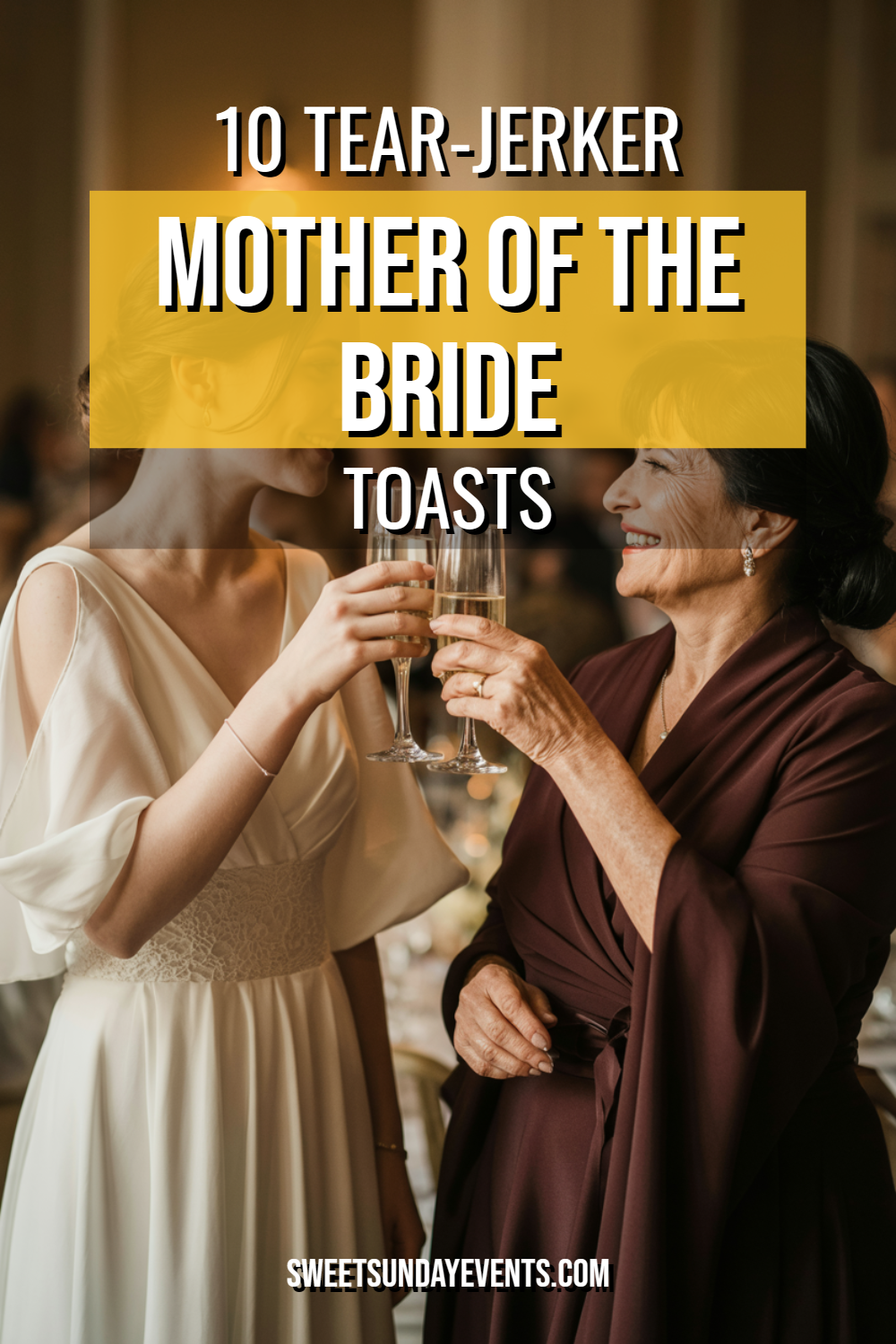When it comes to mother of the bride toasts, there’s a fine line between heartfelt and utterly devastating—in the best possible way.
These moments can transform an entire reception, turning grown men into blubbering messes and making even the most stoic relatives reach for tissues.
1. The Memory Lane Journey
“Twenty-eight years ago, I held a tiny bundle who wouldn’t stop crying at 3 AM. Tonight, I’m watching that same little girl marry the love of her life, and I’m the one who can’t stop crying.
Sarah, you’ve grown from a stubborn toddler who insisted on wearing tutus to the grocery store into a woman who still insists on doing things her way—and I couldn’t be prouder. You taught me that being a mother means learning to let go while never stopping to love fiercely.
Michael, you’re not just gaining a wife; you’re inheriting a woman who will rearrange your entire sock drawer and somehow make your life infinitely better. Welcome to our beautifully chaotic family.”
This toast works because it acknowledges the journey from childhood to adulthood while maintaining the mother’s unique perspective. The humor about the tutus and sock drawer keeps things light while the underlying message about fierce love hits deep.
The beauty lies in how it addresses both the bride and groom directly. It gives the new husband a glimpse into his wife’s character while reassuring him he’s joining something special, even if it comes with reorganized sock drawers.
2. The Strength Recognition Toast
“Emma has always been our family’s quiet warrior. When her father was deployed for eight months, she became my co-pilot, helping with her younger brother without complaint.
When I was diagnosed with breast cancer three years ago, she drove four hours every weekend to sit with me during chemo, bringing terrible magazines and even worse jokes. Tonight, watching her marry James, I see that same strength and devotion she’ll bring to her marriage.
James, you’ve chosen a woman who will stand by you through deployments, diagnoses, and everything in between. She’ll probably bring terrible magazines to make you laugh when life gets hard. You’re the luckiest man alive.”
Raw honesty about family struggles creates an immediate emotional connection. Everyone in the room understands that this isn’t just about a wedding—it’s about recognizing character forged through real hardship.
The toast elevates the bride beyond just being beautiful or sweet. It positions her as someone with proven resilience, which gives weight to the marriage vows about “in sickness and in health.”
3. The Dreams Come True Toast
“When Jessica was eight, she wrote in her diary that she wanted to marry someone who would dance with her in the kitchen while making pancakes. She also wanted seventeen cats and a house made of candy, so I didn’t take the kitchen dancing too seriously.
Last month, I watched David spinning her around their tiny apartment kitchen while they made Sunday breakfast, and I realized some childhood dreams are worth keeping.
Jessica, you never settled for less than someone who sees the magic in ordinary moments. David, thank you for being the kind of man who dances in kitchens and makes my daughter’s eyes light up like she’s still that eight-year-old dreamer.”
Connecting childhood dreams to adult reality creates a powerful narrative arc. It shows the bride’s consistency in knowing what she wanted, even as a child, while acknowledging how dreams evolve.
The specificity of the kitchen dancing makes it feel authentic and relatable. Everyone can picture this scene, which makes the emotional impact more immediate and personal.
4. The Protective Mother Toast
“I’ll be honest—when Rachel first brought Tom home, I was skeptical. Not because there was anything wrong with him, but because I knew my daughter’s heart, and I knew how completely she loves. I was terrified someone might not love her back with the same intensity.
But watching Tom these past three years, I’ve seen him choose Rachel every single day. When she’s cranky before coffee, when she’s stressed about work, when she ugly-cries at dog videos on Instagram—he chooses her.
Tom, you’ve proven that you don’t just love my daughter; you cherish her exactly as she is. Rachel, you found someone worthy of your beautiful, overwhelming heart.”
Vulnerability about initial skepticism makes this toast feel genuine rather than performative. It acknowledges that mothers don’t automatically love everyone their children bring home.
The specific examples of loving someone “when they’re cranky before coffee” ground the toast in real relationship dynamics. It’s not about fairy tale love—it’s about choosing someone when they’re fully human.
5. The Wisdom Passing Toast
“My mother gave me advice before my wedding that I never fully understood until tonight. She said, ‘Marriage isn’t about finding someone to complete you—it’s about finding someone who inspires you to complete yourself.’ Watching Amanda and Chris together, I finally get it.
Amanda, you’ve never needed anyone to complete you; you’ve always been whole. But Chris makes you want to be the best version of yourself, just like you inspire him to grow.
Mom, wherever you are, I finally understand what you meant. And Amanda, I hope someday you’ll pass this wisdom to your own daughter, along with the knowledge that love multiplies when it’s shared.”
Generational wisdom creates a sense of continuity and tradition. It positions the wedding as part of a larger family story that spans generations.
The revelation that the mother is just now understanding her own mother’s advice adds depth. It suggests that marriage wisdom deepens with time and experience.
6. The Transformation Toast
“Five years ago, Lisa came home from college convinced she was going to be single forever. She’d sworn off dating, bought a plant she named ‘Wilson’ for company, and started planning her life as a successful cat lady.
Then she met Kevin at that disastrous New Year’s party where the fire alarm went off twice. Kevin, you not only survived that party, but you also convinced my daughter that love was worth the risk.
Lisa, you went from planning a life alone to planning a life with someone who makes you laugh until you snort. Wilson the plant is still alive, which might be the real miracle here.”
Humor about the plant named Wilson and the snort-laughing keeps the mood light while addressing real fears about love and vulnerability.
The transformation from sworn-off dating to marriage shows genuine character growth. It acknowledges that people change and that the right person can shift our entire perspective on love.
7. The Gratitude Toast
“They say it takes a village to raise a child, but I learned it takes a village to let one go. Mark, you didn’t just win over Jennifer—you won over her protective aunts, her skeptical grandfather, and even her best friend who’s never liked any of her boyfriends.
You showed up to every family barbecue, learned to play her grandfather’s confusing card games, and somehow convinced Aunt Martha that you’re worthy of her famous potato salad recipe.
Jennifer, you found someone who doesn’t just love you—he loves the village that raised you. Mark, thank you for embracing all of us, even when we’re overwhelming, overprotective, and over-involved.”
Acknowledging the extended family’s role in approving the groom creates a sense of community celebration. It shows that this marriage has broader support than just the immediate family.
The specific details about card games and potato salad recipes make the acceptance feel earned rather than automatic. It demonstrates the groom’s genuine effort to integrate into the family culture.
8. The Unexpected Love Toast
“Karen always said she’d never marry someone she met online. She was going to have a romantic, movie-worthy meet-cute story to tell her grandchildren. Instead, she swiped right on a guy whose profile picture featured him wearing a dinosaur costume at what appeared to be a very serious corporate event.
Three years later, I’m watching her marry that same man, and I’ve learned that the best love stories aren’t the ones we plan—they’re the ones that surprise us.
Peter, thank you for being exactly the kind of wonderful weird that matches my daughter’s wonderful weird. Your dinosaur costume game was apparently just the beginning.”
The contrast between expectations and reality creates humor while making a deeper point about keeping an open mind in love.
Calling them both “wonderful weird” normalizes the quirks that make relationships special. It celebrates their unique compatibility rather than trying to fit them into conventional romantic narratives.
9. The Second Chance Toast
“After my divorce, I worried that Stephanie would be afraid of marriage, afraid of taking that leap of faith. Instead, she taught me that watching one marriage end doesn’t mean you stop believing in love—it means you learn to recognize the real thing when it shows up.
Stephanie, you’ve shown more courage in choosing love than I ever did. Marcus, you’re not just marrying my daughter; you’re marrying into a family that’s learned to treasure love because we know how precious it is.
We don’t take happy endings for granted here, which makes tonight even more beautiful.”
Addressing divorce honestly while reframing it as a learning experience shows resilience and growth. It acknowledges family complexity without dwelling on past pain.
The idea that difficult experiences make happy moments more precious gives meaning to past struggles. It suggests that the family’s journey through divorce has prepared them to truly appreciate this celebration.
10. The Full Circle Toast
“Thirty-two years ago, I stood in a hospital room holding my newborn daughter, wondering what kind of woman she’d become. I imagined her first steps, her first day of school, her first heartbreak.
But I never imagined this moment—watching her marry a man who makes her laugh so hard she snorts, who brings her coffee in bed every morning, and who somehow convinced her that pineapple belongs on pizza.
Daniel, you’ve done the impossible—you’ve made my daughter even happier than I dreamed possible. Tonight, as I watch you two begin your own family, I’m not losing a daughter. I’m gaining a son who will probably try to convince me that pineapple belongs on pizza too.”
The full circle from birth to marriage creates a powerful emotional arc. It shows how a mother’s dreams for her child have been exceeded by reality.
Ending with humor about pineapple on pizza keeps the mood celebratory while acknowledging that the family dynamic is expanding rather than contracting.
The Art of Delivery
The difference between a good toast and a legendary one often comes down to delivery. These toasts work because they feel conversational rather than rehearsed, even when they’ve been carefully crafted.
Practice doesn’t mean memorizing every word perfectly. It means being comfortable enough with your message that you can speak from the heart, even if you stumble or add spontaneous thoughts.
Timing and Preparation
The best mother of the bride toasts happen when emotions are high but not overwhelming. Usually, this means speaking after dinner but before the party really gets going.
Keep tissues handy—not just for yourself, but for your daughter. These moments are designed to be emotional, and that’s exactly what makes them so memorable.
Finding Your Own Voice
Each of these toasts works because it reflects the unique relationship between mother and daughter. Your toast should capture your specific journey together, your inside jokes, your shared struggles, and your hopes for her future.
The goal isn’t to make everyone cry—it’s to honor your daughter and welcome your new son-in-law in a way that feels authentically you. Whether that’s through humor, vulnerability, or pure celebration, the best toasts come from the heart.


